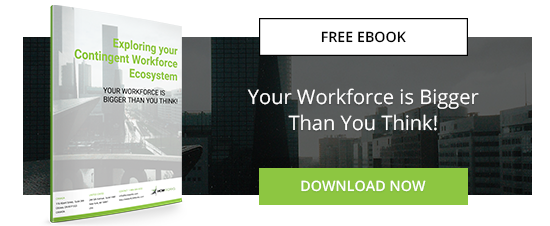There’s no doubt that the use of contingent labor is on the rise industry wide. Companies are now using consultants, freelancers, temps, independent contractors, statement-of-work laborers and other non-permanent workers as part of their overall corporate strategies. These workers are not on the company’s payroll but provide important services to the organization. Hiring them comes with certain benefits and risks.
Flexibility to Respond to Market Conditions
One of the best aspects of hiring contingent workers is the flexibility that it provides employers. They can hire and let go independent contractors whenever necessary, without the worry of firings, layoffs, or severance packages. With such a fluctuating and fragile economy, it’s vital for organizations to be able to quickly respond, change, and adapt to market conditions. This flexibility could be the factor that determines their future success.
Cost Savings
Another significant motivation to hiring contingent workers is the cost savings that come with this shift away from the traditional workforce. You don’t have to pay them for non-productive time or downtime. They also aren’t entitled to the same types of benefits as regular employees, such as sick leave, vacation time, holiday pay, and health insurance. You pay contingent workers for the work they perform and that is all. Once the required work is completed, the worker simply moves on.
Bridging the Skills Gap
There is a shortage of workers with critical skill sets in today’s job market. Many companies are faced with a skills gap in their current workforces that they are trying to bridge. With the baby-boomer generation starting to retire, the cost in labor rising for skilled workers, and huge advancements in technology, companies cannot keep up with the necessary skills needed to perform all of their daily operations.
This has resulted in a year-by-year growth in the size of the contingent workforce as companies seek individuals with specialized skills to complete projects or supplement internal talent capabilities. While highly skilled workers can be expensive to hire on a full-time basis, the costs are more acceptable when they’re only hired temporarily when needed.
Different Management Approach Is Needed
As the contingent workforce is relatively new in corporate America, many organizations are not skilled enough to manage it effectively. These workers aren’t paid in the same way, receive different types of benefits, require a different style of management, and come with their own liabilities and risks.
Many companies are still managing them with ad hoc and high-risk tactics and inadequate technology instead of investing in an integrated workforce management strategy that would maximize productivity, increase efficiency, and reduce costs. Without a management strategy targeted specifically to contingent labor, companies aren’t able to optimize their new workforce, negating many of its potential benefits.
Legal and Compliance Risks
Misclassifying true employees as contingent workers is a huge risk that comes with using this type of labor. When employers do not take the required steps to ensure that they are classifying their workers correctly, they risk legal and regulatory challenges.
The government can pursue them for the error and seek significant fines and penalties. And workers who believe they were wrongly classified could file lawsuits to gain the payments and benefits they think they should be entitled to, such as holiday pay, overtime, health coverage, and RSP contributions.
Competitive Risks
Companies that use contingent workers are also at an increased risk of spilled information. Organizational knowledge, trade secrets, and intellectual property can be exposed by past contingent workers who go on to work for a competitor.
Minimize Risks for Maximum Rewards
Many organizations are jumping on board and taking advantage of contingent workers. After all, the contingent workforce allows for added flexibility, lowered costs, and greater talent. But with these benefits come the risks of poor management, misclassification, and leaked information. Companies can only reap the rewards of contingent workers if they are effectively mitigating the risks that come with hiring them.



